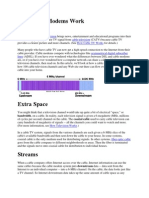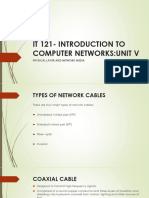0 ratings0% found this document useful (0 votes)
108 viewsNetwork Cabling
Network Cabling
Uploaded by
GokulCj GroveThis document discusses different types of network cabling. It describes the main types as unshielded twisted pair (UTP), shielded twisted pair (STP), coaxial cable, and fiber optic cable. For each type, it provides details on their construction, common uses, maximum speeds and distances supported, and connector types. UTP is the most commonly used for Ethernet networks due to its flexibility and cost effectiveness. Fiber optic cable can support the highest speeds over longest distances. The cable type chosen depends on the network topology, protocols, size and bandwidth needs.
Copyright:
© All Rights Reserved
Available Formats
Download as PPTX, PDF, TXT or read online from Scribd
Network Cabling
Network Cabling
Uploaded by
GokulCj Grove0 ratings0% found this document useful (0 votes)
108 views45 pagesThis document discusses different types of network cabling. It describes the main types as unshielded twisted pair (UTP), shielded twisted pair (STP), coaxial cable, and fiber optic cable. For each type, it provides details on their construction, common uses, maximum speeds and distances supported, and connector types. UTP is the most commonly used for Ethernet networks due to its flexibility and cost effectiveness. Fiber optic cable can support the highest speeds over longest distances. The cable type chosen depends on the network topology, protocols, size and bandwidth needs.
Original Title
Network cabling
Copyright
© © All Rights Reserved
Available Formats
PPTX, PDF, TXT or read online from Scribd
Share this document
Did you find this document useful?
Is this content inappropriate?
This document discusses different types of network cabling. It describes the main types as unshielded twisted pair (UTP), shielded twisted pair (STP), coaxial cable, and fiber optic cable. For each type, it provides details on their construction, common uses, maximum speeds and distances supported, and connector types. UTP is the most commonly used for Ethernet networks due to its flexibility and cost effectiveness. Fiber optic cable can support the highest speeds over longest distances. The cable type chosen depends on the network topology, protocols, size and bandwidth needs.
Copyright:
© All Rights Reserved
Available Formats
Download as PPTX, PDF, TXT or read online from Scribd
Download as pptx, pdf, or txt
0 ratings0% found this document useful (0 votes)
108 views45 pagesNetwork Cabling
Network Cabling
Uploaded by
GokulCj GroveThis document discusses different types of network cabling. It describes the main types as unshielded twisted pair (UTP), shielded twisted pair (STP), coaxial cable, and fiber optic cable. For each type, it provides details on their construction, common uses, maximum speeds and distances supported, and connector types. UTP is the most commonly used for Ethernet networks due to its flexibility and cost effectiveness. Fiber optic cable can support the highest speeds over longest distances. The cable type chosen depends on the network topology, protocols, size and bandwidth needs.
Copyright:
© All Rights Reserved
Available Formats
Download as PPTX, PDF, TXT or read online from Scribd
Download as pptx, pdf, or txt
You are on page 1of 45
Network Cabling
Cable is the medium through which information
usually moves from one network device to another.
There are several types of cable which are commonly
used in LANS.
The type of cable chosen for a network is related to
the network’s topology, protocol, and size.
Types of Network Cables
Unshielded Twisted Pair (UTP) Cable
Shielded Twisted Pair (STP) Cable
Coaxial Cable
Fiber optic cable
Twisted Pair Cables
Two Types Of Twisted Pair Cables
Unshielded Twisted Pair (UTP) Cable
Shielded Twisted Pair (STP) Cable
UTP & STP Cable
UTP Cable
Unshielded Twisted Pair (UTP) Cable
UTP is simply twisted pair cabling that is unshielded.
The quality of UTP may vary from telephone-grade wire to
extremely high-speed cable.
The cable has four pairs of wires inside the jacket.
Each pair is twisted with a different number of twists per
inch to help eliminate interference from adjacent pairs and
other electrical devices.
The tighter the twisting, the higher the supported
transmission rate and the greater the cost per foot.
The EIA/TIA (Electronic Industry
Association/Telecommunication Industry Association) has
established standards of UTP and rated six categories of wire.
Unshielded Twisted Pair Connector
The standard connector for unshielded twisted pair
cabling is an RJ-45 connector.
This is a plastic connector that looks like a large
telephone-style connector.
A slot allows the RJ-45 to be inserted only one way. RJ
stands for Registered Jack, implying that the connector
follows a standard borrowed from the telephone
industry.
This standard designates which wire goes with each
pin inside the connector.
Straight – Through Cable
The wire on the both side are on the same order. You
can determine that the wiring is a straight-through
cable by holding both ends of the UTP cable side by
side and seeing that the order of the wires on both
ends is identical.
You can use a straight-through cable for the
following tasks:
Connecting a router to a hub or switch
Connecting a server to a hub or switch
Connecting workstations to hub or switch
Crossover Cable
In the implementation of a crossover, the wires on
each end of the cable are crossed.
It is used to transmit and receive for both rip and ring.
Pin 1 on one side connects to pin 3 on the other side,
and pin 2 connects to pin 6 on the opposite end.
You can use a crossover cable for the
following tasks:
Connecting uplinks between switches
Connecting hubs to switches
Connecting a hub to another hub
Connecting a router interface to another router
interface
Connecting two PCs together without a hub or switch
Rolled Over Cable
In rolled over cable, the wires on each of the cable are
opposite. It broadcast to receive and receive to
transmit on both side, for both tip and ring. Pin 1 on
the one side connects to pin 8 on the other side, pin 2
connects to pin 7 on the opposite end, pin 3 connects
to pin 6 on the opposite end and pin 4 connects to pin
5 on the opposite end.
For out of band console connection between the
console port (RJ45) of the manageable switches and
the com port (DB9) of the computer using a RJ45 to
DB9 terminal.
For out of band console connection between the
console port (RJ45) of manageable routers and the
com port (DB9) of the computer using a RJ45 to DB9
terminal.
Ethernet Cable Summary
Specification Cable Type
10BaseT Unshielded Twisted Pair
10Base2 Thin Coaxial
10Base5 Thick Coaxial
100BaseT Unshielded Twisted Pair
100BaseFX Fiber Optics
100BaseBX Single Mode Fiber
100BaseSX Multimode Fiber
1000BaseT Unshielded Twisted Pair
1000BaseFX Fiber Optic
1000BaseBX Single Mode Fiber
1000BaseSX Multimode Fiber
At last some basic guide lines when
installing cable
Always use more cable than you need. Leave plenty of
slack.
Test every part of a network as you install it. Even if it
is brand new, it may have problems that will be difficult
to isolate later.
Stay at least 3 feet away from fluorescent light boxes
and other sources of electrical interference.
If it is necessary to run cable across the floor, cover the
cable with cable protectors.
Label both ends of each cable.
Use cable ties (not tape) to keep cables in the same
location together.
Categories of Unshielded Twisted Pair
UTP Data Max.Length Cable Type Application
Category Rate(Speed) Use
CAT1 Up to 1Mbps - Twisted Pair Old Telephone
Cable(Voice only)
CAT2 Up to 4Mbps - Twisted Pair Local Talk & Telephne-
Rarely used(Token Ring
Networks)
CAT3 Up to 10Mbps 100m Twisted Pair Token Ring & 10BASE-T
Ethernet
CAT4 Up to 16Mbps 100m Twisted Pair Token Ring
Networks(Rarely used)
CAT5 Up to 100Mbps 100m Twisted Pair Ethernet, Fast Ethernet,
Token Ring
CAT5e Up to 1Gbps 100m Twisted Pair Ethernet, Fast Ethernet,
Gigabyte Ethernet
CAT6 Up to 10Gbps 100m Twisted Pair Gigabyte Ethernet, 10G
Shielded Twisted Pair (STP) Cable
STP is same as UTP except that STP has a braided foil
shield around the twisted pair (to decrease electrical
interference).
Shielded twisted pair cable is available in three different configurations
Each pair of wires is individually shielded with foil.
There is a foil or braid shield inside the jacket covering
all wires (as a group).
There is a shield around each individual pair, as well as
around the entire group of wires (referred to as double
shield twisted pair).
Unshielded & Shielded Network Cables
Coaxial Cable
A Coaxial cable is a cable used in the transmission of video,
communications, and audio. ...
Most users relate to a coaxial or coax cable as a cable used to
connect their TVs to a cable TV service.
However, these cables are also used in networks and what
allow a broadband cable Internet connection using a cable
modem.
Coaxial cabling has a single copper conductor at its center.
A plastic layer provides insulation between the center
conductor and a braided metal shield.
The metal shield helps to block any outside interference from.
What is the use of coaxial cable?
Coaxial cable is used as a transmission line for radio
frequency signals.
Its applications include feed lines connecting radio
transmitters and receivers with their antennas,
computer network (Internet) connections,
digital audio (S/PDIF), and distributing
cable television signals.
Which connector is used for coaxial cable?
BNC Connectors
To Connect coaxial cable to device, it is necessary to
use coaxial connector.
The most common type of connector is the Bayone-
Neill-Concelman, or BNC, connector.
There are three types:
1. BNC connector
2. BNC T connector
3. BNC Terminator
Coaxial cable connector
Application include cable TV networks, and some traditional Ethernet LANs
like 10Base-2 or 10Base5.
Types of coaxial cable
Two Types Of Coaxial Cable
1. Thin coaxial cable
2. Thick coaxial cable
Thin coaxial cable
10BASE2 (also known as cheapernet, thin Ethernet,
thinnet, and thinwire) is a variant of Ethernet that
uses thin coaxial cable, terminated with BNC
connectors.
The approximate maximum segment length being 200
meters.
Thick coaxial cable
10BASE5 (also known as thick Ethernet or thicknet)
was the first commercially available variant of
Ethernet.
10BASE5 uses a thick and stiff coaxial cable up to
500 meters (1,600 ft) in length.
Thick coaxial cable has an extra protective plastic
cover that helps keep moisture away from the center
conductor.
This makes thick coaxial a great choice when
running longer lengths in a linear bus network.
Fiber Optical Cable
A fiber optic cable consists of a bundle of glass threads,
each of which is capable of transmitting messages
modulated onto light waves.
Fiber optics has several advantages over traditional
metal communications lines.
Fiber optic cables have a much greater bandwidth than
metal cables.
A light-emitting diode (LED) or an injection-laser diode
(ILD) can be used for generating the light pulses.
Using a lens, the light pulses are funneled into the fiber-
optic medium where they travel down the cable.
Types of Fiber Optical Cable
There are three types of fiber optic cable commonly
used.
single mode,
multimode and
plastic optical fiber (POF).
Transparent glass or plastic fibers which allow light to
be guided from one end to the other with minimal
loss.
OM1 or OM2 OS1 or Os2 Single
OM3 or OM4Laser Optimized Polarization Maintaining
Multimode(Orange) mode(Yellow) OS1 or Os2 Single
Multimode(Aqua) Singlemode Fiber(Blue)
mode(Red)
single mode fiber
In optical fiber technology, single mode fiber is
optical fiber that is designed for the transmission of
a single ray or mode of light as a carrier and is used
for long-distance signal transmission. For short
distances, multimode fiber is used.
. A typical single mode optical fiber has a core
diameter between 8 and 10.5 µm and a
cladding diameter of 125 µm.
Single-mode fiber (SMF) – Widely used for
communications
multimode fiber
In optical fiber technology, multimode fiber is
optical fiber that is designed to carry multiple light rays or
modes concurrently, each at a slightly different reflection
angle within the optical fiber core. ... For longer distances,
single mode fiber (sometimes called monomode) fiber is
used.
A basic specification of a multimode fiber contains the core
diameter and the outer diameter of a multimode fiber.
Common types for fiber-optic communications (see below)
are 50/125 μm and 62.5/125 μm fibers, having a core diameter
of 50 μm or62.5 μm, respectively, and a cladding diameter
of 125 μm.
Multi-mode fiber (MMF) – Used for office networks
Glass optical fiber
Multi-component glass optical fiber -- Widely used
along with POF for lighting
Plastic Optical Fiber
Plastic Optical Fiber, (POF), typically uses PMMA
(acrylic), a general-purpose resin as the core material,
and fluorinated polymers for the cladding material.
In large-diameter fibers, 96 percent of the cross-
section is the core that facilitates the transmission of
light.
PMMA plastic optical fiber(POF) -- Consumer short-
distance fiber for electronic appliances and motor
vehicles
Why fiber optic cable is better?
And fiber optics can definitely transfer more data at
higher throughput over longer distances than copper
wire. ...
Traditional copper wires transmit electrical currents,
while fiber optic technology sends pulses of light
generated by a light emitting diode or laser
along optical fibers.
What are the uses of optical fibers?
Optical fibres have become very important in high-
speed communications, such as cable TV and high-
speed broadband services.
Information, in the form of pulses of light, is sent
down bundles of optical fibers.
Fiber optic cables are able to carry more signals than
traditional copper cable telephone lines.
What is the diameter of fiber optic cable?
The size of the optical fiber is commonly referred to by
the outer diameter of its core, cladding and coating.
Example: 50/125/250 indicates a fiber with a core of 50
microns, cladding of 125 microns, and a coating of
250 microns.
You might also like
- OpenText ContentBridge CE 21.2 - User Guide English (EDCCM210200-UGD-En-1)Document456 pagesOpenText ContentBridge CE 21.2 - User Guide English (EDCCM210200-UGD-En-1)nippanisasiNo ratings yet
- 13 5Document5 pages13 5jaiganeshv1991No ratings yet
- Fiber Optic TestingDocument18 pagesFiber Optic TestingViệt Đặng XuânNo ratings yet
- FCGA Definition of Terms - Revisions2017 PDFDocument9 pagesFCGA Definition of Terms - Revisions2017 PDFDiego ZABALANo ratings yet
- 20104AS16 b-1Document26 pages20104AS16 b-1Mani Rathinam RajamaniNo ratings yet
- LAN Cable Preparation For BeginnersDocument9 pagesLAN Cable Preparation For BeginnersAaditya ShahNo ratings yet
- Cambium Networks PresentationDocument43 pagesCambium Networks PresentationAdvantec Srl100% (1)
- Fault Tolerant Ethernet Delivers Robust Networking Solution For Experion PKSDocument6 pagesFault Tolerant Ethernet Delivers Robust Networking Solution For Experion PKSKhalid AliNo ratings yet
- Fiber Optic CommunicationDocument4 pagesFiber Optic Communicationeaglett100% (1)
- Lab 3 Full Fiber OpticDocument3 pagesLab 3 Full Fiber OpticAmeerul SalimNo ratings yet
- Of ClassificationDocument33 pagesOf ClassificationManoj BorahNo ratings yet
- FTTH Cable SpecificationsDocument5 pagesFTTH Cable SpecificationsArmando Esquivada0% (2)
- Maxis Fiber InstallationDocument15 pagesMaxis Fiber InstallationMuhamad Ashraff100% (1)
- Fiber To The AntennaDocument20 pagesFiber To The AntennaNuno FernandesNo ratings yet
- Accessories: Europe/Middle East/Africa Product Selection GuideDocument68 pagesAccessories: Europe/Middle East/Africa Product Selection GuideShiela Monique FajardoNo ratings yet
- Fiber Optic Testing TroubleshootingDocument47 pagesFiber Optic Testing TroubleshootingTetsusaigaNo ratings yet
- Network DesignDocument346 pagesNetwork DesignpeterabulenciaNo ratings yet
- Cable Blowing Machine Miniflow RAPID Operating ManualDocument15 pagesCable Blowing Machine Miniflow RAPID Operating ManualJoseph ThomasNo ratings yet
- Fiber Optic NotesDocument7 pagesFiber Optic NotesAmin JamaludinNo ratings yet
- Module 4.optical AmplifiersDocument30 pagesModule 4.optical AmplifiersPreetham M. C Preetham M. CNo ratings yet
- Optec Catalogue PDFDocument98 pagesOptec Catalogue PDFVijay Lakshmipathy0% (1)
- GPON: The Standard For PON Deployment and Service Evolution: OSI Confidential InformationDocument23 pagesGPON: The Standard For PON Deployment and Service Evolution: OSI Confidential Informationchaidar_lakareNo ratings yet
- DSLDocument27 pagesDSLgaurav_juneja_4No ratings yet
- HOW GPON WorkDocument13 pagesHOW GPON WorkHarsh Zaveri100% (1)
- Understanding OM1, OM2, OM3, OS1, OS2 Fiber PDFDocument3 pagesUnderstanding OM1, OM2, OM3, OS1, OS2 Fiber PDFaldebaran0473No ratings yet
- r000 HST Broadcom XDSL UserGuideDocument108 pagesr000 HST Broadcom XDSL UserGuideChristian BurgosNo ratings yet
- NEW Advanced Communication Laboratory ManualDocument54 pagesNEW Advanced Communication Laboratory Manualkeerthans_150% (4)
- OTN Session-How To Build Future-Oriented and Ultra-Broadband Optical Transport NetworksDocument33 pagesOTN Session-How To Build Future-Oriented and Ultra-Broadband Optical Transport Networksjoemervin1971No ratings yet
- Photonic Switching - Lecture 1Document60 pagesPhotonic Switching - Lecture 1Shivam GuptaNo ratings yet
- Glosario FTTHDocument34 pagesGlosario FTTHJOSE DANNY SIESQUEN CHAMBERGONo ratings yet
- Finisar Optical Transceiver Product Guide 3 2015 WebDocument5 pagesFinisar Optical Transceiver Product Guide 3 2015 WebfgdllkjlklkNo ratings yet
- LESSON 2-Network-CablingDocument46 pagesLESSON 2-Network-CablingJ A Y T R O NNo ratings yet
- Exfo in Band Osa MjerenjeDocument4 pagesExfo in Band Osa MjerenjeFatima MasloNo ratings yet
- BraidDocument5 pagesBraidLi-chung JeaNo ratings yet
- Reference Guide To Fiber Optics: The Fiber Optic Association, IncDocument23 pagesReference Guide To Fiber Optics: The Fiber Optic Association, InckoneNo ratings yet
- By Aman Teno: Asymmetric Digital Subscriber Line TO O&M PerformanceDocument24 pagesBy Aman Teno: Asymmetric Digital Subscriber Line TO O&M PerformanceAmanNo ratings yet
- Wireline vs. WirelessDocument9 pagesWireline vs. WirelesshadiwdaaNo ratings yet
- Transmission in Optical Fiber CommunicationDocument78 pagesTransmission in Optical Fiber CommunicationakmzamanNo ratings yet
- Fibreflow CatalogueDocument124 pagesFibreflow CatalogueOmair MustafaNo ratings yet
- 4 - Measurement in A DWDM SystemDocument10 pages4 - Measurement in A DWDM SystemAnonymous 5Pzs8gpVQNo ratings yet
- Anixter Standards Reference Guide: Anixter: The Cabling System ExpertsDocument36 pagesAnixter Standards Reference Guide: Anixter: The Cabling System ExpertsniantonsNo ratings yet
- User Guide Intelligent Optical Link Mapper FTB-1 English (1060268)Document131 pagesUser Guide Intelligent Optical Link Mapper FTB-1 English (1060268)mousa34No ratings yet
- LTE/LTE A Interference Coordination For FemtocellsDocument98 pagesLTE/LTE A Interference Coordination For FemtocellsRoy Naldo Nathaniel SihotangNo ratings yet
- 1 Dept. of Electronics & CommunicationDocument18 pages1 Dept. of Electronics & CommunicationApurva SharmaNo ratings yet
- Anote101 AngDocument24 pagesAnote101 AngpratapNo ratings yet
- 04 Web Fiber Present enDocument34 pages04 Web Fiber Present enmfarouk1No ratings yet
- Aerial/Underground: Fiber Optic Splice GuideDocument1 pageAerial/Underground: Fiber Optic Splice GuideRobert HedrickNo ratings yet
- T Rec G.8275.1 201606 I!!pdf eDocument56 pagesT Rec G.8275.1 201606 I!!pdf epabu sacilatNo ratings yet
- How Cable Modems WorkDocument6 pagesHow Cable Modems WorkboyetcincoNo ratings yet
- Advantages of G655 Fiber Over G652 FiberDocument6 pagesAdvantages of G655 Fiber Over G652 Fibercarlosmena1987No ratings yet
- OFC-Joints & ConnectionsDocument51 pagesOFC-Joints & ConnectionsDeepika DhalNo ratings yet
- Drive Test 100208Document150 pagesDrive Test 100208mitmap123No ratings yet
- User Guide PPM 350C English 1063122Document47 pagesUser Guide PPM 350C English 1063122Huy DuNo ratings yet
- Optical and Microwave Technologies for Telecommunication NetworksFrom EverandOptical and Microwave Technologies for Telecommunication NetworksNo ratings yet
- Cabling 150323050229 Conversion Gate01 PDFDocument23 pagesCabling 150323050229 Conversion Gate01 PDFDidith GambaNo ratings yet
- What Is Network CablingDocument7 pagesWhat Is Network CablingpegawaihepNo ratings yet
- Unit 5-Physical Layer and Network MediaDocument31 pagesUnit 5-Physical Layer and Network Medialevisqueen26No ratings yet
- Computer Network Lab ManualDocument51 pagesComputer Network Lab ManualR -BrotHERsNo ratings yet
- Network CablingDocument19 pagesNetwork CablingAli DoyoNo ratings yet
- Information Sheet 3.1Document10 pagesInformation Sheet 3.1Danica De GuzmanNo ratings yet
- CN FileDocument26 pagesCN FileShaktiNo ratings yet
- Q3 Module2 G11 CSS NCII Sison Central Is BlueDocument8 pagesQ3 Module2 G11 CSS NCII Sison Central Is BluexzainahanielmartinezNo ratings yet
- Siddharth Group of Institutions:: Puttur: Unit - IDocument7 pagesSiddharth Group of Institutions:: Puttur: Unit - IGokulCj GroveNo ratings yet
- Directive Principles of State PolicyDocument15 pagesDirective Principles of State PolicyGokulCj GroveNo ratings yet
- 19CS61CDocument2 pages19CS61CGokulCj GroveNo ratings yet
- Yye (2021-2022) Question Paper 1Document34 pagesYye (2021-2022) Question Paper 1GokulCj GroveNo ratings yet
- Eligibility Criteria: Focused AreasDocument2 pagesEligibility Criteria: Focused AreasGokulCj GroveNo ratings yet
- Department of Civil Engineering GE8076 - Professional Ethics in Engineering Unit IV - MCQ BankDocument6 pagesDepartment of Civil Engineering GE8076 - Professional Ethics in Engineering Unit IV - MCQ BankGokulCj GroveNo ratings yet
- Product Design and Development: Thoufiq Mohammed K Ap / MechDocument15 pagesProduct Design and Development: Thoufiq Mohammed K Ap / MechGokulCj GroveNo ratings yet
- Constitution of Kuwait: BY: Gokulakrishnan M 1912058Document17 pagesConstitution of Kuwait: BY: Gokulakrishnan M 1912058GokulCj GroveNo ratings yet
- Cse AjaxDocument20 pagesCse AjaxGokulCj GroveNo ratings yet
- Advanced Encryption StandardDocument26 pagesAdvanced Encryption StandardGokulCj GroveNo ratings yet
- U - III Propositional LogicDocument37 pagesU - III Propositional LogicGokulCj GroveNo ratings yet
- 15EC29L - Syllabus and ReferenceDocument2 pages15EC29L - Syllabus and ReferenceGokulCj GroveNo ratings yet
- General Format For Final AccountsDocument2 pagesGeneral Format For Final AccountsGokulCj GroveNo ratings yet
- Models For Software Product Quality (1) - 1Document50 pagesModels For Software Product Quality (1) - 1Learning StrengthNo ratings yet
- WerterDocument5 pagesWertertestNo ratings yet
- Xii Physics-Investigatory Project TransformerDocument16 pagesXii Physics-Investigatory Project TransformerDharambati Mahananda100% (1)
- RohozaDocument3 pagesRohozaPolina RohozaNo ratings yet
- Planning and BroadbandDocument79 pagesPlanning and BroadbandJillian SeitzNo ratings yet
- Resume Dhruva Kumar KRDocument2 pagesResume Dhruva Kumar KRdhruvakumarkr45No ratings yet
- Module 1. Empowerment IntroDocument18 pagesModule 1. Empowerment IntroLuisa SevillaNo ratings yet
- Combining Data in Pandas With Merge, .Join, and Concat - Real PythonDocument2 pagesCombining Data in Pandas With Merge, .Join, and Concat - Real PythonJorge ForeroNo ratings yet
- Feasibility Study Project Proposal "Setting Up A Software House"Document5 pagesFeasibility Study Project Proposal "Setting Up A Software House"Asjad IqbalNo ratings yet
- 243 IST ANTEA CONDENSING ERP GAR AEE EN CompressedDocument76 pages243 IST ANTEA CONDENSING ERP GAR AEE EN CompressedMarian GrecuNo ratings yet
- Lithium Battery Date CodesDocument1 pageLithium Battery Date CodesAbhaya RanawakaNo ratings yet
- VPLEX™ Upgrades: Implementation Planning and Best PracticesDocument8 pagesVPLEX™ Upgrades: Implementation Planning and Best PracticesrosennedkovNo ratings yet
- SUBMISSIONDocument7 pagesSUBMISSIONS.Qassim AlalawiNo ratings yet
- Sequential CircuitsDocument33 pagesSequential CircuitsPrasun SinghalNo ratings yet
- Mulitiparametrical Monitor - MX-300 - EMAI-TransmaiDocument1 pageMulitiparametrical Monitor - MX-300 - EMAI-TransmaiClub2011No ratings yet
- Module 2 Communication and GlobalizationDocument13 pagesModule 2 Communication and GlobalizationwintermaeNo ratings yet
- TBC300A-DCA6 (DV Normal Temp Area) Outdoor Datasheet 01-20161129Document1 pageTBC300A-DCA6 (DV Normal Temp Area) Outdoor Datasheet 01-20161129Danilo SilvaNo ratings yet
- Shortest Path Algorithm For GPS Guided RobotDocument23 pagesShortest Path Algorithm For GPS Guided RobotVishakh ShewalkarNo ratings yet
- FW1020 20.0v1 Deploying Sophos Firewall Using The Initial Setup WizardDocument19 pagesFW1020 20.0v1 Deploying Sophos Firewall Using The Initial Setup Wizarddiego.mendezNo ratings yet
- Siri Kademani: WebsiteDocument4 pagesSiri Kademani: WebsiteSyed Ismail KhadryNo ratings yet
- Anaplan Connector Guide: Informatica Cloud (Fall 2015)Document35 pagesAnaplan Connector Guide: Informatica Cloud (Fall 2015)Kishore ReddyNo ratings yet
- 216Mhz Single Channel Crystal Controlled A/V Modulator: Headend & ElectronicsDocument2 pages216Mhz Single Channel Crystal Controlled A/V Modulator: Headend & ElectronicsMauro Barragan SanchezNo ratings yet
- Class 9 Half YearlyDocument7 pagesClass 9 Half YearlyPradoshNo ratings yet
- Gis Mapping Revenue Department RFP 3956 - 3Document50 pagesGis Mapping Revenue Department RFP 3956 - 3Prakash VermaNo ratings yet
- Read This FirstDocument9 pagesRead This FirstmoryNo ratings yet
- 14 - NuMicro Supporting SoftwareDocument17 pages14 - NuMicro Supporting SoftwareThienNo ratings yet
- VN-10253213 - Item ListDocument40 pagesVN-10253213 - Item List628078No ratings yet
- Led TV: Service ManualDocument28 pagesLed TV: Service ManualMihaela CaciumarciucNo ratings yet






































































































